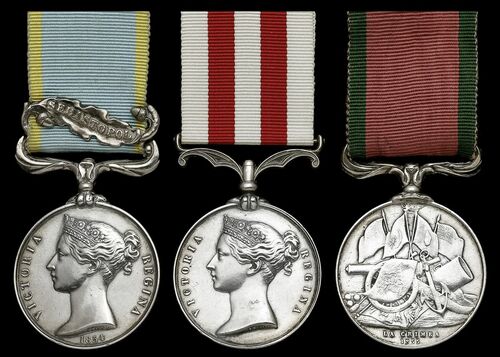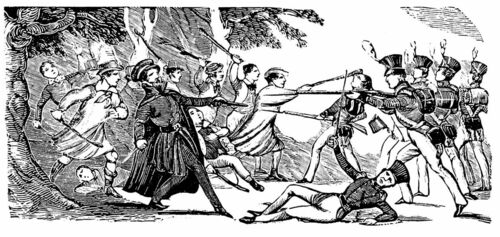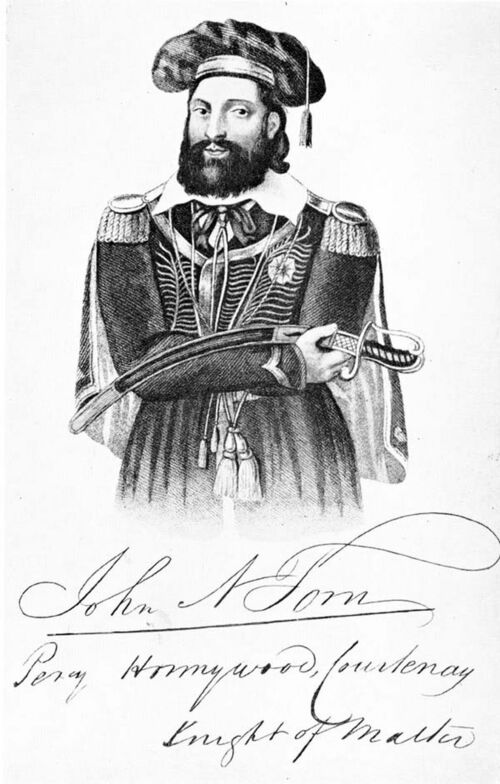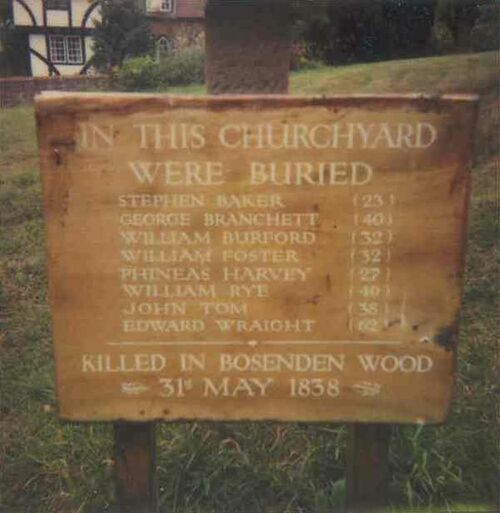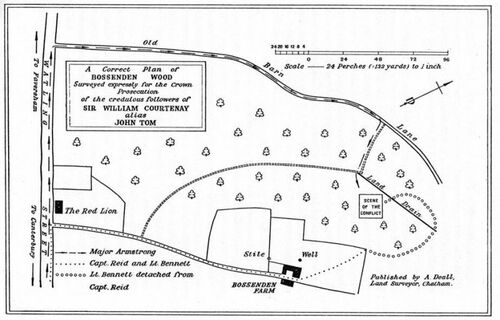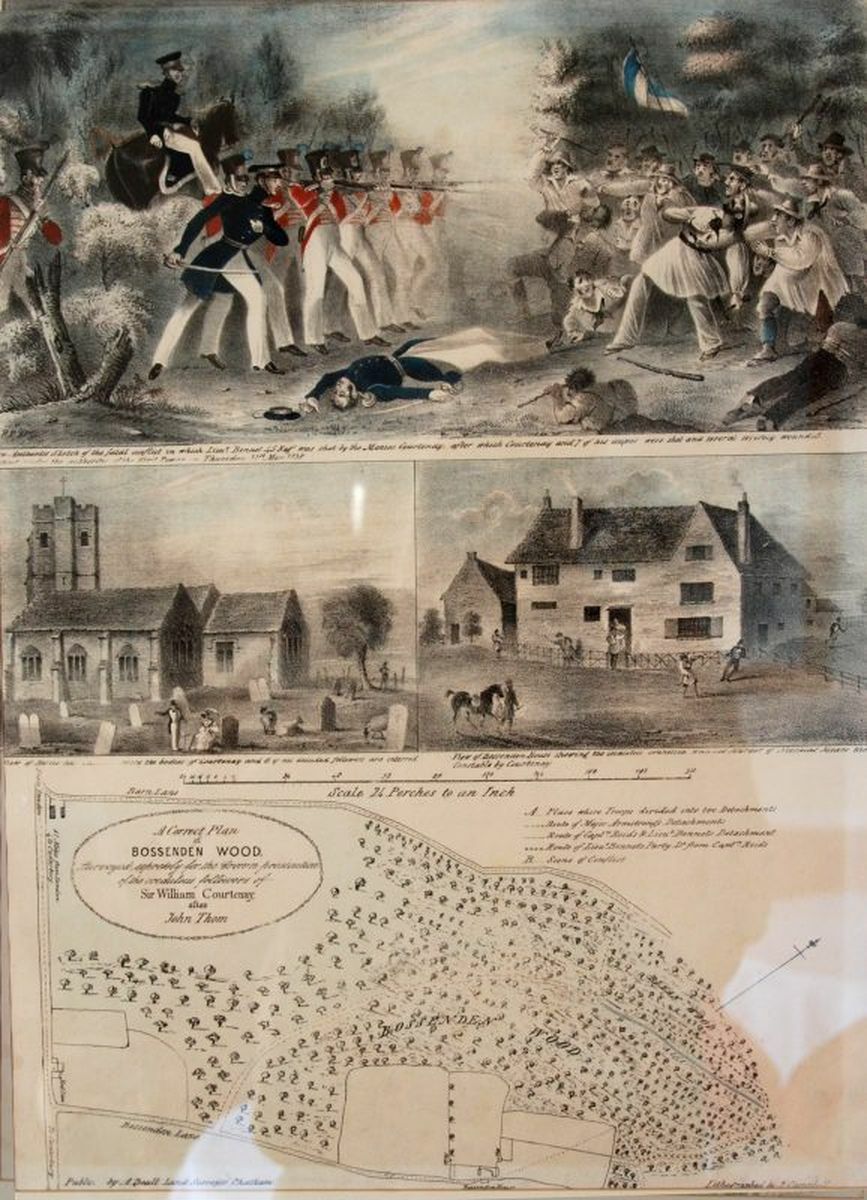Auction: 23003 - Orders, Decorations and Medals
Lot: 153
The campaign group of three awarded to Lieutenant-Colonel C. B. Roche, 34th (Cumberland) Regiment of Foot, who was one of three Officers who commanded the Battle of Bossenden Wood in May 1838 - which was the last Battle fought on British soil
Crimea 1854-56, 1 clasp, Sebastopol (Capt C. B. Roche. 34th Regt.), officially impressed naming; Indian Mutiny 1857-59, no clasp (Paymr, C, B, Roche. 34th Regt); Turkish Crimea 1855, Sardinian issue, plugged and fitted with Crimea-style suspension, light contact marks, otherwise very fine (3)
Charles Boyse Roche was born in 1807 at Ramsgate, Kent. He served as a first-class Volunteer in the Sherwood Foresters prior to joing the Army. He became an Ensign on 18 January 1828 and was advanced Lieutenant on 21 June 1832, Paymaster in the 34th Regiment of Foot on 30 November 1838, leaving the 45th Regiment where he took over from Paymaster G. Ledingham.
He was one of the three officers who had charge of the Military Detachment sent to Bosenden Wood, near Canterbury, on 31 May 1838, to disperse the followers of the impostor Sir William Courtenay, who was actually John Nichols Tom, a Truro maltster who had spent four years in Kent County Lunatic Asylum. The three were Lieutenant Bennett (whom Courtenay shot), Ensign Roche and Ensign Crawley, who afterwards became General Crawley. Faversham Life gives more detail:
'On 29 May 1838, which was Oak Apple Day, a public holiday celebrating the Restoration, Courtenay and his followers began to march around the countryside with a flag and the symbol of protest, a loaf of bread on a pole. Their activities were peaceful but, possibly mindful of the Swing riots only eight years before, some landowners started to feel uneasy and on 31 May 1838, a local magistrate Dr Poore, issued a warrant for Courtenay’s arrest.
The parish constable of Boughton-under-Blean, his assistant, and his brother Nicholas Mears, set off early to Bossenden Farm where Tom and his followers were staying. Courtenay shot Nicholas Mears dead, and the constable and his assistant hastened to the magistrates who sent to Canterbury for assistance. A detachment of the 45th Foot was despatched from the barracks, led by Major Armstrong with three junior officers and about a hundred soldiers.
Mr Knatchbull, a local magistrate in Faversham, decided to deal with the matter himself and rode out with a posse of about 14 men on horseback to the osier beds near Fairbrook Farm where Courtenay and his men had decamped. They numbered 30 to 40 now as some of his followers had fled. There was a stand-off. Courtenay and his band retreated to Bossenden Wood. Dr Poore, Mr Knatchbull and more than a hundred soldiers of the 45th Foot were waiting at The Red Lion Inn in Dunkirk. William Courtenay was to be captured dead or alive.
In a pincer movement, Major Armstrong led a troop into the wood through Old Barn Lane, while Captain Reid’s detachment entered the wood further to the east through Bossenden Farm. The battle lasted no more than a few minutes. On the rioters side, only Courtenay and William Wills had guns. The rest of the band were armed with cudgels and sticks. The only soldier to die was Lieutenant Bennett of Captain Reid’s party who advanced too impetuously to arrest Courtenay and was shot dead by Wills. George Catt, a special constable from Faversham, was fatally shot by a soldier who mistook him for a rioter. In seconds, eight of Courtenay’s party were dead and seven lay injured, one so seriously wounded that he died later that day.'
When the struggle in Bosenden Wood was over Ensign Roche was left in command of the soldiers who mounted guard over Courtenay's body.
Roche served in America before going to serve in the Crimea and later the Indian Mutiny. He became Paymaster to the Cavalry Depot at Maidstone in November 1858, transferring from the 34th Foot, vice Cubitt and was given the rank of Major on 1 January 1860. He became Paymaster at the Cavalry Depot, Canterbury on 31 May 1871 and was placed on retired pay with the Honorary Rank of Lieutenant-Colonel in January 1881.
Subject to 20% VAT on Buyer’s Premium. For more information please view Terms and Conditions for Buyers.
Sold for
£1,100
Starting price
£600

